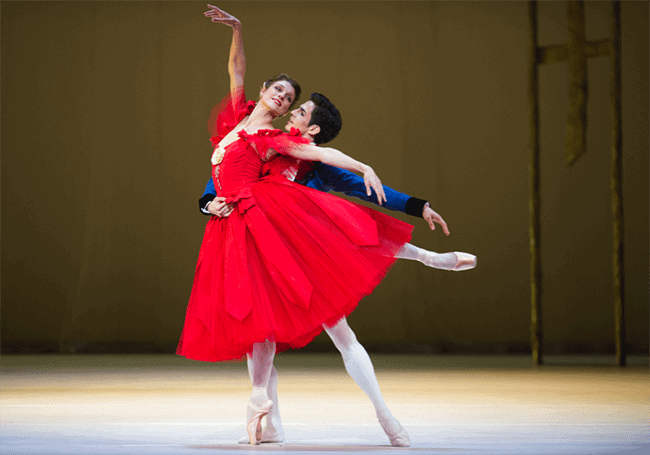The Royal Ballet: Standing up to Ashton
Posted: March 1st, 2013 | Author: Nicholas Minns | Filed under: Performance | Tags: Alexander Campbell, Anthony Crickmay, Épaulement, Federico Bonelli, Geraldine Morris, La Valse, Marguerite and Armand, Meditation from Thais, Monotones I and II, Rupert Pennefather, Sarah Lamb, Sir Frederick Ashton, The Royal Ballet, Tristram Kenton, Voices of Spring, Yuhui Choe, Zenaida Yanowski | Comments Off on The Royal Ballet: Standing up to AshtonThe Royal Ballet, La Valse, ‘Meditation’ from Thais, Voices of Spring, Monotones I and II, Marguerite and Armand: Royal Opera House, February 13

The beauty of line in Sir Frederick Ashton’s ballets is one of the defining characteristics of his work, even if the steps can be excruciatingly complex. What goes on in the feet is one thing, but in The Royal Ballet’s evening of six works by Ashton, there is ample opportunity — particularly in Monotones I and II — to see the lines of the body beautifully expressed with grace and precision. Unfortunately those qualities were not always in evidence the night I went, though the stretch body suits may have had something to do with it, deforming rather than streamlining the natural joints of the body. The real problem lies elsewhere, however.
Geraldine Morris, in her book, Frederick Ashton’s Ballets: Style, Performance, Choreography, spends some time discussing the ballet training Ashton would have received, particularly the Cecchetti system that was the basis of his technique. She quotes Cecchetti scholar, Toby Bennett: ‘Cecchetti-trained dancers not only have strength and flexibility in the torso, they also have an appreciation of the subtle rhythmic variations between different steps, coupled with a profound understanding of épaulement.’ Épaulement is not an intellectual concept that needs profound understanding; its profundity is in its manifestation in the body: it is as fundamental to classical form as the double helix is to the structure of DNA. In ballets like Monotones I and II, dancers who do not have ‘a profound understanding of épaulement’ — or who sacrifice it to flexibility — will not be able to maintain the purity of line Ashton’s choreography demands. Romany Pajdak possibly had an off night, but her difficulty in maintaining equilibrium in certain passages of Monotones I may have had its source in a failure to implement Ashton’s — and Cecchetti’s — indispensable ingredient. Mark Monahan in his discussion of Ashton in the evening’s program describes épaulement as ‘that irresistibly feminine angling of the head and shoulders.’ It is not; he is mistaking the flower for the stem.
A few pages further on in her book, Morris discusses the differences she sees in the way Ashton’s original casts performed his works compared with today’s. ‘What stands out is the speed at which the dances are performed. Today’s slightly slower tempo gives rise to an alteration of the choreography. While the steps are ostensibly the same, their appearance is not. What is lost is the sense of dancing. The poses, moments of stillness and turnout are emphasized in the later version but the sense of motion is absent and the dances are seen more as a set of links between positions.’ I cannot agree or disagree with Morris as I have not seen footage of the original casts, and she is not necessarily referring to any of the ballets on this evening’s bill, but her comparison turned a light on my own reaction to the evening’s middle section, which included ‘Meditation’ from Thais, Voices of Spring, as well as Monotones I and II. In ‘Meditation’ from Thais, Sarah Lamb and Rupert Pennefather had a rather bloodless quality that put precision ahead of expression, shape ahead of form, position ahead of flow. The juice remained in the music under the direction of Emmanuel Plasson with concert master Vasko Vassilev playing the violin solo. The highlight of this middle section, however, was seeing Alexander Campbell and Yuhui Choe in Voices of Spring. With their sensitivity, exuberance and evident joy in dancing together, they were as close to spring as one could wish at this time of year.
The evening opened with La Valse and closed with Marguerite and Armand. After Ashton had choreographed the latter on Margot Fonteyn and Rudolph Nureyev, it remained, as David Vaughan writes in the program, the ‘exclusive property of Fonteyn and Nureyev for many years.’ It is a flawed ballet that can only be saved from a whimpering melodrama by the passionate interpretation and charisma of its two protagonists. But the sparks were simply not flying between Zenaida Yanowski and Federico Bonelli, if there were sparks at all. It is not a ballet in which there can be any notion of pretense. Bonelli’s passion needs unlocking so that Yanowski has a chance to spar. I wanted to shout out to him, Embrace her as if you really love her! Compare the photographs in the program: Bonelli and Yanowski are beautifully captured by Tristram Kenton, with foreheads passionately furrowed, but then look at the photograph by Anthony Crickmay of Fonteyn and Nureyev in rehearsal and you see a world in which the entire body explodes in passion. Marguerite and Armand — and its creator — demand no less.